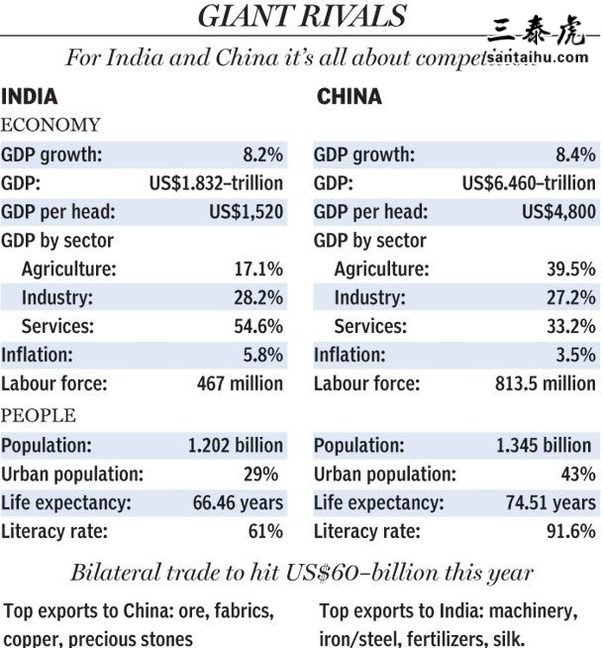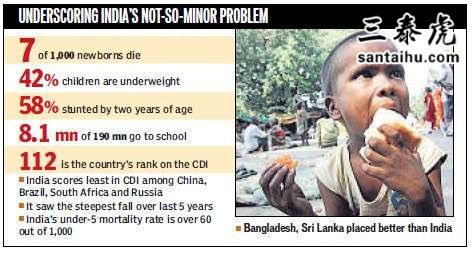Going through its labor peak due to Demographic dividend
and India have comparable population, but has 80% more workers than India. How? It is because of temporary condition of Demographic dividend where a number of new kids drop rapidly and a significant portion of the population are the kids of yesterday - who are now healthy adults ready to work. The nation can focus a lot on educating these few kids and can assure better literacy and development. This shift pushed up Japan after WW2. is going through this bulge. [Unfortunately, this is only a temporary help as Japan later found out in 1990s. Eventually lack of new kids will affect your labor population 30 years from now.]
人口红利带来劳动力高峰
和印度的人口相当,但的工人比印度多80%。怎么做到的?这是因为暂时的人口红利状况,但新出生的孩子数量迅速下降,而且人口中很大一部分是昨天出生的孩子,他们现在是能够投入工作的健康成年人。国家可以专心教育这些孩子上,确保更好的识字能力和发展。这一转变推动了二战后日本的发展。正在经历这种大发展。[不幸的是,这只是日本在上世纪90年代得到的短暂助益。最终,新生儿的缺乏将影响30年后的劳动力人口。]

Ameya Rao, Political Science Enthusiast
I see many people have answered this question giving numbers such as GDP figures, amount of exports, amount of foreign exchange reserves, developed infrastructure etc. is anyways light-years ahead of India in terms of GDP or infrastructure or amount of foreign exchange reserves. This is no doubt to 's advantage, but let me focus more on some "other advantages" which has:
- Demographics: is a country whereby around 80 or even 90% of the population belongs to one single ethnicity and race. So this means that 80 to 90% of the people speak same language, are of same religion, and are of same race. This is a major advantage which has over India (which is culturally, racially, linguistically diverse). This also helps to have a "non-federal" kind of government structure.
- Government and Politics: Due to India's racial and linguistic diversity, it has a multi-party, federal de ocracy. Apart from the fact that India is stable due to de ocracy and there are less chances of a coup or any kind of social unrest, its slow de ocracy can also be to its disadvantage. E.g. it can take 10, 20, or even 30 years for an average Indian city to get a metro train system, while it can take just 5 years for an average city.
- History: was (almost) never ruled by any foreign power. The Mongol invasion was in pockets and not a 'rule' as such. This has preserved culture, customs, language, religion etc. Hence they don't have problems like Hindus vs Seculars, Hindi vs Tamil, Indo-Persian culture of North India vs native culture of South India etc. Further, foreign rule in India completely messed up Indian people's psychology due to media propaganda - first by Muslim Kingdoms, then by British, and finally by Seculars.
我看到很多人已经回答了这个问题,给出了一些数据,比如GDP、出口量、外汇储备量、发达的基础设施等等。无论如何,就GDP、基础设施或外汇储备量而言,比印度领先了好几光年。这无疑对有利,但让我更关注一些拥有的“其他优势”:
1。人口:是一个大约80%甚至90%人口属于单一民族的国家。这意味着80%到90%的人说同一种语言,信仰同一宗教,属于相同民族。这是比印度(在文化、种族、语言上具有多样性)的主要优势。
2。印度的种族和语言多样性,多个党派,其缓慢的民*可能对其不利。例如,一个普通的印度城市需要10年、20年甚至30年才能建成地铁系统,而普通城市只需要5年时间。
3。历史:几乎从来没有被外国势力统治过。这使得的文化、习俗、语言、宗教等得以保留。因此他们没有印度教对世俗、印度教对泰米尔、印度波斯文化对北印度本土文化等问题。此外,印度的外国统治通过媒体宣传-首先由msl王国,然后由英国,最后由世俗,完全扰乱了印度人的心理。
Rohit Shinde, MS in CS at Rutgers University, GSoC 2015
's biggest advantage over India is its one party rule.
In India, there are many groups hampering development. This got so frustrating that recently a minister even stated that the reason for projects getting delayed is the number of protests that arise over small issues.
Manufacturing
The world over, is viewed as a manufacturing hub while India is viewed as a marketplace to ship finished goods. This causes disparity in income levels between the two countries.
Manufacturing creates more jobs than services ever will. India gets most of its GDP from the services sector. Also, manufacturing provides more economic equality than the services.
Being a manufacturing hub, almost every major company in the world, has its manufacturing centre in . This attracts a lot of investment in and leads to job creation.
对印度最大的优势是一党执政。
在印度,有许多阻碍发展的组织。这种情况过于严重,以至于最近一位部长甚至表示,项目被推迟的原因就是小问题引起的抗议活动过多。
制造业
被视为全球制造业中心,而印度被视为商品销售市场。这导致了两国收入水平的差异。
制造业创造的就业机会永远比服务业多。印度的国内生产总值大部分来自服务业。此外,制造业提供比服务业更多的经济平等。
作为一个制造中心,几乎世界上所有的大公司都在设有制造中心。这为吸引了大量的投资,并创造了就业机会。
Special Economic Zones
has strategically located SEZs in various places and its SEZs are so efficient that the Shenzhen SEZ is responsible for almost a third of 's exports. has designated the entire province of Hainan as a SEZ.
Comparing that to India, we see that India's SEZs are languishing. Policies are ambiguous and different SEZs are treated differently. In fact, the only industry which has benefited from the SEZs is the IT industry.
经济特区
在许多地区都设立了具有战略地位的经济特区,经济特区的效率非常高,深圳经济特区的出口量几乎占据了出口总量的三分之一,把整个海南省列为经济特区。
与印度相比,印度的经济特区萎靡不振。政策含糊不清,不同的经济特区受到不同的对待。事实上,只有一个IT业从经济特区获益。
Demography
As Balaji Viswanathan said, is going through a demographic dividend right now. The sheer size of — a huge country with a population of 1.3 billion — greatly magnifies the advantages of effective state-led growth and sophisticated manufacturing. It produces the benefit of economy of scale. She builds huge EPZ (Export Processing Zones) out of nothing; now houses two-thirds of the world’s total number of EPZs workers. This advantage helps to build three basic manufacturing clusters, each with its own specialization.
The first is the Pearl River Delta (including Hong Kong as the main channel for export), which specializes in labor intensive manufacturing, production of spare parts and their assembly.
The second is the Yangtze River Delta, specializing in capital intensive industries: cars, semiconductors, mobile phones and notebooks, computers etc.
The third cluster is Zhongguan Cun, Being, the Silicon Valley. Here the state directly intervenes to make possible the collaboration of colleges, enterprises and state banks to develop the IT industry. Meanwhile state colleges are also turning out huge numbers of college graduates — comparable to developed countries. In 2002 had 590,000 college graduates majoring in science and technology, whereas Japan had 690,000 one or two years earlier, and Thailand only 10,000.
人口
正如Balaji Viswanathan所说,正在经历人口红利。幅员辽阔,人口13亿,极大地放大了国家主导的有效增长和先进制造业的优势。带来了规模经济效益。白手起家,建立了庞大的出口加工区;现在拥有世界三分之二的出口加工区工人。这种优势有助于建立三个基本的制造业地区,每个地区都有自己的专业化。
第一个是珠江三角洲(包括香港作为出口的主要渠道),专门从事劳动密集型制造业、零部件生产和组装。
第二个是长江三角洲,专门从事资本密集型产业:汽车、半导体、移动电话和笔记本、计算机等。
第三个是中关村,硅谷。在这里,国家直接干预,让学院、企业和国有银行合作发展IT产业成为可能。同时,国家大学也培养了大量的大学毕业生,与发达国家相当。2002年,有59万名毕业于科学技术专业的大学毕业生,而日本一两年前有69万,泰国仅有1万。
Moiz Lokhandwala, studied Marketing & International Business at University of Wollongong (2018)
's comparative advantages over India:
1) has higher values of most social indicators of living standards such as life expectancy, infant mortality rate, coverage of immunisation, etc
2) has a better infrastructure to promote R&D in the field of science and technology and is more capable of develo a better and more advanced military force.
3)s current overall GDP is 3 times larger than India's and by 2025 the difference is estimated at $4.4 trillion annually.
4)s spendings on defence is about 6 times more than India, which keeps them in a better position in that sense
5) industrial growth in dwarfs India's growth, due to the massive manpower available, making it one of the largest manufacturer globally.
相对于印度的优势:
1)大多数社会生活水平指标如预期寿命、婴儿死亡率、免疫接种率的表现都更为优秀。
2)有更好的基础设施来促进科技领域的研发,且更有能力发展更优秀更先进的军事力量。
3)目前的国内生产总值是印度的3倍,到2025年,这一差距将达到每年4.4万亿美元。
4)的国防开支大约是印度的6倍,从这个意义上说,这让他们处于更有利的地位。
5)的工业增长使印度的增长相形见绌,因为拥有大量的劳动力,使其成为全球最大的制造国之一。
Shuo Yang, Coding peasant and civil economist
have much higher IQ than Indians.
的IQ比印度人高多了。
Abhinav Bhaskar, Mechanical Engineer,debater,social equality enthusiast
people (the present generation ) do not associate themselves with any religion .
(这一代人)不信仰宗教。
Anonymous
- Hard work (we are lazy people)
- language (here more than 50% Indians struggles between mother tongue and English)
- No caste based politics/rights
- no damage to public property
- They eat everything
- 工作努力(我们印度人很懒惰)
- 语言(印度有超过50%的人在母语和英语之间挣扎)
- 无种姓政治/权利
- 不损害公共财产
- 他们什么都吃
Shri Sarghuru, Human | Engineer | Programmer
Less corruption
Population
Technology
Cheap product production
Effective usage of resources
腐败情况较少
人口
技术
商品生产成本低
资源的有效利用
Deepak Dhanwade, Musician
is mean, cunning, and mighty.
India is too soft.
卑鄙,狡猾,有势力。
印度太软弱了。
此文由 三泰虎 编辑,未经允许不得转载!:首页 > 印度 » 中国对印度有什么优势

 印度空军重新调整现代化计划,推动“印度制造”
印度空军重新调整现代化计划,推动“印度制造” 印度新冠肺炎确诊病例突破10万例,死亡病例超过3000例
印度新冠肺炎确诊病例突破10万例,死亡病例超过3000例 印度财政部长:可以通过多种形式把钱发到人们手中
印度财政部长:可以通过多种形式把钱发到人们手中 印度食品部宣布:15天内向8000万民工发放免费口粮
印度食品部宣布:15天内向8000万民工发放免费口粮 印度开展药品外交,向拉美及加勒比海国家、非洲国家伸出援助之手
印度开展药品外交,向拉美及加勒比海国家、非洲国家伸出援助之手 你认为印度现在最需要什么
你认为印度现在最需要什么 印度北方邦卡车事故造成26名民工死亡,36人受伤
印度北方邦卡车事故造成26名民工死亡,36人受伤 印度北方邦两卡车相撞,致23名民工死亡
印度北方邦两卡车相撞,致23名民工死亡